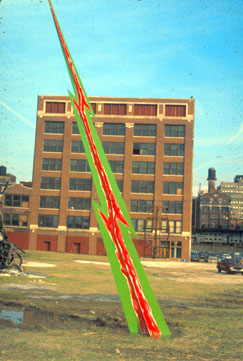 Green Lightning, 1984. Steel,
LEXAN, tin, transformers, neon, electricity, wire, animators and concrete.
Billie Lawless.
Green Lightning, 1984. Steel,
LEXAN, tin, transformers, neon, electricity, wire, animators and concrete.
Billie Lawless.
Green Lightning
was originally conceived as a project at Artpark, Lewiston, New York for
the 1983 season (maquette submitted).
It was subsequently
erected in Buffalo, New York in 1984 (Video
Clip of Dedication) and heavily damaged a week after its unveiling
by the City of Buffalo and City of Buffalo Arts Commission (Director, David
More.) Its total destruction was prevented when Lawless obtained a court
order halting the destruction which was begun by the City under the cloak
of darkness well after the Courts had closed.
Lawless was one
of eight artists accepted to exhibit at Sculpture Chicago '85 in
the Spring of 1985. The jurors, Howard Fox of the Los Angeles County Museum
of Art, Mary Jane Jacobs of the Museum of Contemporary Art, Chicago, IL
and John Chandler, Director of Supervision, Art Consultancy and Management,
Boston, MA, selected Lawless'
Green Lightning (2
minute video clip) which was subsequently installed at Harrison and
Wells Streets in the South Loop. It stood for five years with no controversy
(5
minute video clip for those with patience).
In 1992 a jury
in the New York State Supreme Court ruled that the Mayor of the City of
Buffalo and the City of Buffalo Urban Renewal Agency had violated Mr. Lawless'
civil rights with its unauthorized actions in 1984.
In the Spring
of 1993 Green Lightning
was accepted into an exhibition to be held
at the Manhattan Psychiatric Center in New York, New York. The exhibition
was sponsored by the Association of Independent Artists and curated by
John Rosis and Glenn Reed (See prospectus for
this exhibiton).
When the Director
of the Center (Michael Ford) voiced his objections to the sculpture both
curators (artists living in New York City) attempted to pressure Lawless
into submitting another piece.
Lawless refused and the American
Civil Liberties Union initiated litigation.
Justice Ira Gammerman
of the New York State Supreme Court ruled that the Manhattan Psychiatric
Center did have to exhibit the piece but that it was not required to give
Lawless the site which he had requested. The Center offered a piece of
land which was not large enough to hold the sculpture which effectively
precluded Lawless from exhibiting the piece.
No artists from
the exhibition voiced any support for Lawless.
-
Article in Buffalo News, November
22, 1984. Judge Rips Griffin, Bars Sculpture Razing.
-
Article in Buffalo
Arts Review, Winter, 1984. The Public Ordeal of Billie Lawless by
George Howell
-
Article in Chicago Tribune,
November, 1985. Sculpture Office Developers display art in a Quest for
Prestige.
-
Article in Buffalo News,
November 10, 1985. 'Green Lightning' Strikes Chicago as Unobjectionable
-
Article in New York Times, February,
1985. Artists Go to Court to Restore Sculpture in Buffalo.
-
Article in New York Newsday,
June 24, 1993. All Dressed up with Nowhere to Go
-
Article in the Village Voice, March,
1994. Controversy.

